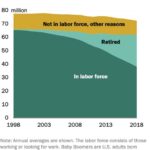
Sellers need to adjust their expectations to the current market as homes are sitting longer, according to real estate agents who are urging a shift in mindset away from the frenzied conditions of 2021.
The once-red-hot housing market is undergoing a significant correction, prompting real estate professionals to advise sellers to recalibrate their strategies and pricing expectations. The days of bidding wars and houses selling far above asking price are largely over, replaced by a more balanced market where buyers have increased leverage. As inventory rises and interest rates remain elevated, sellers who cling to inflated valuations risk having their properties linger on the market.
“Sellers need to wake up! It isn’t 2021 anymore,” emphasizes one real estate agent, reflecting a sentiment echoed across the industry. This statement underscores the necessity for sellers to acknowledge the changed landscape and adapt accordingly.
The shift is evident in several key market indicators. Days on market (DOM), a crucial metric indicating how long a property remains listed before being sold, have increased substantially in many areas. In 2021, homes often sold within days, if not hours, of being listed. Now, it’s not uncommon for properties to remain on the market for weeks or even months, especially if they are overpriced.
“The market has definitely cooled off,” notes another agent. “Buyers are more discerning and have more options. They’re not willing to overpay, and they’re taking their time to find the right property.”
One of the primary drivers of this market correction is the rise in mortgage rates. After years of historically low rates, the Federal Reserve’s efforts to combat inflation have led to a significant increase in borrowing costs. This has priced many potential buyers out of the market, reducing demand and putting downward pressure on prices.
“Higher mortgage rates have definitely taken a bite out of affordability,” explains a mortgage broker. “Many people who could comfortably afford a home a year ago are now priced out of the market due to the increase in interest rates.”
The increase in housing inventory is another factor contributing to the shift. As more homes come onto the market, buyers have more choices, which reduces competition and gives them more negotiating power. This is a stark contrast to the inventory shortage that characterized the market in 2020 and 2021, when buyers often had to compete fiercely for a limited number of properties.
“We’re seeing more inventory come onto the market, which is good news for buyers,” says one analyst. “It gives them more options and more time to make a decision.”
In light of these changes, real estate professionals are urging sellers to take a more realistic approach to pricing their homes. This means carefully evaluating comparable sales data, considering the current market conditions, and being willing to negotiate with buyers.
“Pricing your home correctly from the start is crucial,” advises an experienced realtor. “Overpricing can scare away potential buyers and lead to the property sitting on the market for an extended period. It’s better to price it competitively and attract multiple offers.”
Staging a home effectively is also more important than ever. With buyers having more options, it’s essential to make a property stand out from the competition. This means decluttering, making necessary repairs, and creating a welcoming atmosphere.
“Staging can make a huge difference in how a home is perceived by buyers,” says a professional home stager. “It helps them visualize themselves living in the space and can increase the perceived value of the property.”
The shift in the housing market has also affected the types of properties that are most in demand. While luxury homes and investment properties are still selling, the strongest demand is now for affordable, move-in-ready homes in desirable locations.
“Buyers are looking for value,” explains one agent. “They want homes that are well-maintained, in good school districts, and priced reasonably.”
For sellers who are willing to adapt to the changing market conditions, there are still opportunities to successfully sell their homes. However, it requires a more strategic and realistic approach than it did during the peak of the market.
“The market is still active, but it’s not the same as it was a year or two ago,” says one real estate expert. “Sellers who are willing to listen to their agents, price their homes competitively, and be patient are more likely to succeed.”
The need for professional guidance is greater than ever, as navigating the complexities of the current market requires expertise and experience. Real estate agents can provide valuable insights into local market conditions, pricing strategies, and negotiation tactics.
“Working with a good real estate agent is essential in this market,” says one buyer. “They can help you find the right property, negotiate a fair price, and navigate the closing process.”
In conclusion, the housing market has undergone a significant transformation, requiring sellers to adjust their expectations and strategies. The days of easy sales and inflated prices are largely over, replaced by a more balanced market where buyers have more power. By pricing their homes realistically, staging them effectively, and working with experienced real estate professionals, sellers can still achieve success in the current market.
Detailed Analysis
The article effectively highlights the critical shift occurring in the real estate market. The initial boom, fueled by record-low interest rates and pandemic-induced demand, has given way to a more sober reality. The article correctly identifies the key drivers of this change, including rising mortgage rates, increased housing inventory, and a more discerning buyer pool.
The emphasis on the need for sellers to “wake up” and adjust their expectations is particularly relevant. Many sellers are still holding onto the unrealistic notion that they can command the same prices as they did during the peak of the market. This is a dangerous assumption that can lead to properties lingering on the market for extended periods, ultimately forcing sellers to lower their prices anyway.
The article’s discussion of days on market (DOM) is also crucial. DOM is a key indicator of market health, and the increase in DOM signals a slowdown in sales velocity. This means that sellers need to be prepared for a longer selling process and adjust their marketing strategies accordingly.
The impact of higher mortgage rates on affordability is another critical point. As interest rates rise, the cost of borrowing money increases, making it more difficult for potential buyers to afford a home. This reduces demand and puts downward pressure on prices.
The increase in housing inventory is also a significant factor. With more homes on the market, buyers have more choices, which gives them more negotiating power. This means that sellers need to be more competitive in terms of pricing and staging in order to attract buyers.
The article’s advice to sellers on pricing their homes realistically is essential. Overpricing a home is one of the biggest mistakes a seller can make, as it can deter potential buyers and lead to the property sitting on the market for an extended period.
The importance of staging a home effectively is also highlighted. In a more competitive market, it’s essential to make a property stand out from the competition. Staging can help create a welcoming atmosphere and increase the perceived value of the property.
The article also touches on the changing demand for different types of properties. While luxury homes and investment properties are still selling, the strongest demand is now for affordable, move-in-ready homes in desirable locations. This reflects the fact that many buyers are looking for value and are not willing to overpay for a property.
Finally, the article emphasizes the importance of working with a qualified real estate agent. A good agent can provide valuable insights into local market conditions, pricing strategies, and negotiation tactics.
Expanded Context and Background Information
To fully understand the current real estate market, it’s important to consider the historical context that led to the recent boom and subsequent correction.
The COVID-19 pandemic played a significant role in driving up housing prices. As people spent more time at home, they began to reevaluate their living situations. Many decided to move to larger homes or to more desirable locations. At the same time, interest rates were at historically low levels, making it more affordable to buy a home.
These factors combined to create a perfect storm for a housing boom. Demand for homes surged, while supply remained limited. This led to bidding wars and skyrocketing prices.
However, the boom was not sustainable. As the economy began to recover, the Federal Reserve started to raise interest rates in an effort to combat inflation. This led to a significant increase in mortgage rates, which cooled down the housing market.
The increase in mortgage rates has had a ripple effect throughout the economy. It has made it more expensive for people to buy homes, which has reduced demand for housing. This has also led to a slowdown in the construction industry, as builders are less likely to start new projects when demand is weak.
The current housing market is characterized by uncertainty. It’s difficult to predict exactly what will happen in the future. However, it’s likely that the market will continue to cool down in the coming months.
Sellers who are realistic about their pricing expectations and who are willing to work with qualified real estate agents are more likely to succeed in the current market. Buyers who are patient and who are willing to shop around are more likely to find a good deal.
Impact on Various Stakeholders
The changing real estate market impacts several key stakeholders differently:
-
Sellers: As highlighted in the article, sellers need to adjust their expectations significantly. The days of quick sales above asking price are largely gone. Sellers now need to price their homes competitively, invest in staging and potentially repairs, and be prepared for longer selling timelines. The emotional aspect of selling, especially for those who have lived in a home for many years, can make it difficult to accept the current market reality. Those who bought at the peak of the market and are now selling may even face selling at a loss.
-
Buyers: Buyers now have more power than they did in recent years. Increased inventory and reduced competition mean they have more choices and more time to make decisions. While higher mortgage rates still pose a challenge to affordability, buyers have the opportunity to negotiate prices and terms. First-time homebuyers, who struggled to compete in the frenzied market, now have a better chance of entering the housing market.
-
Real Estate Agents: Real estate agents play a crucial role in guiding both buyers and sellers through the changing market. They need to be adept at advising sellers on realistic pricing strategies and helping buyers navigate the increased inventory. Agents who can effectively communicate the realities of the market and provide expert guidance will be the most successful. The need for strong marketing skills and negotiation abilities is heightened.
-
Mortgage Lenders: Mortgage lenders are facing a challenging environment due to higher interest rates and reduced demand. They need to adapt to the changing market by offering competitive loan products and providing expert advice to borrowers. The rise in interest rates also increases the risk of mortgage defaults, requiring lenders to carefully assess borrowers’ ability to repay their loans.
-
Home Builders: Home builders are facing a slowdown in demand due to higher interest rates and increased inventory. They need to adjust their construction plans and pricing strategies to reflect the changing market conditions. Some builders may reduce construction activity or offer incentives to attract buyers.
-
The Economy: The real estate market is a significant driver of the economy. A slowdown in the housing market can have a ripple effect throughout the economy, impacting construction, retail sales, and other industries. The Federal Reserve’s monetary policy, particularly interest rate adjustments, plays a crucial role in shaping the housing market and overall economic activity.
Future Outlook and Potential Scenarios
The future of the real estate market remains uncertain, with several potential scenarios:
-
Scenario 1: Gradual Stabilization: The market continues to cool down gradually, with prices stabilizing over time. Interest rates remain relatively stable, and inventory continues to increase at a moderate pace. Buyers and sellers adjust to the new market conditions, and the market eventually reaches a new equilibrium.
-
Scenario 2: Significant Correction: The market experiences a more significant correction, with prices declining sharply. This could be triggered by a recession, a further increase in interest rates, or a sharp increase in housing inventory. Sellers face significant losses, and buyers become even more cautious.
-
Scenario 3: Unexpected Rebound: The market experiences an unexpected rebound, with prices starting to rise again. This could be triggered by a sudden drop in interest rates, a surge in demand, or a decrease in housing inventory. Sellers regain the upper hand, and buyers face increased competition.
-
Scenario 4: Regional Variations: The market experiences significant regional variations, with some areas remaining relatively stable while others experience more significant corrections or rebounds. This could be due to differences in local economies, demographics, and housing supply.
The actual outcome will likely depend on a complex interplay of factors, including economic conditions, government policies, and consumer behavior. It’s essential to monitor these factors closely to assess the potential risks and opportunities in the real estate market.
FAQ Section
Q1: What does it mean when real estate agents say “It isn’t 2021 anymore?”
A1: This phrase encapsulates the significant shift in the housing market from the peak frenzy of 2021. In 2021, demand far exceeded supply, leading to bidding wars and homes selling quickly above asking price. Now, the market is more balanced, with increased inventory and higher mortgage rates giving buyers more leverage. Sellers can no longer expect the same conditions and need to adjust their expectations and strategies accordingly. They must embrace realistic pricing, potentially make improvements, and be patient for the right buyer.
Q2: Why are homes sitting on the market longer now?
A2: Several factors contribute to homes staying on the market longer:
- Higher Mortgage Rates: Increased interest rates make it more expensive for buyers to borrow money, reducing affordability and demand.
- Increased Inventory: With more homes available, buyers have more choices and are less likely to rush into a purchase.
- Overpricing: Sellers clinging to peak-market valuations often list their homes too high, deterring potential buyers.
- Buyer Discernment: Buyers are more cautious and have more time to evaluate properties, leading to longer decision-making processes.
- Economic Uncertainty: General economic anxieties can make buyers hesitant to commit to large purchases.
Q3: How can sellers adjust to the current market conditions?
A3: Sellers can adapt to the changing market by:
- Pricing Competitively: Conduct thorough market research and price the home realistically based on comparable sales and current conditions.
- Staging Effectively: Present the home in its best light by decluttering, making necessary repairs, and creating a welcoming atmosphere.
- Being Flexible: Be willing to negotiate with buyers and consider offers that may be lower than initially expected.
- Working with a Professional: Enlist the expertise of a qualified real estate agent who can provide valuable guidance and marketing strategies.
- Patience: Understand that the selling process may take longer than it did in the past and be prepared to wait for the right buyer.
Q4: What are the main factors influencing the current housing market?
A4: The key factors shaping the current housing market include:
- Mortgage Rates: Interest rates directly impact affordability and buyer demand.
- Housing Inventory: The supply of homes available influences competition and pricing.
- Economic Conditions: Overall economic health, including employment rates and inflation, affects consumer confidence and spending.
- Consumer Sentiment: Buyers’ attitudes and expectations regarding the market play a role in their willingness to purchase.
- Federal Reserve Policy: The Federal Reserve’s monetary policy decisions, such as interest rate adjustments, can significantly influence the housing market.
Q5: Is now a good time to buy a home?
A5: Whether now is a good time to buy depends on individual circumstances and financial readiness.
- Potential Benefits: Increased inventory and reduced competition give buyers more choices and negotiating power. Prices may be more reasonable than in recent years.
- Potential Drawbacks: Higher mortgage rates increase the cost of borrowing money. Economic uncertainty may make some buyers hesitant.
- Recommendations: Carefully assess your financial situation, get pre-approved for a mortgage, and work with a qualified real estate agent to find the right property at a fair price. Consider long-term financial goals and stability before making a decision.









